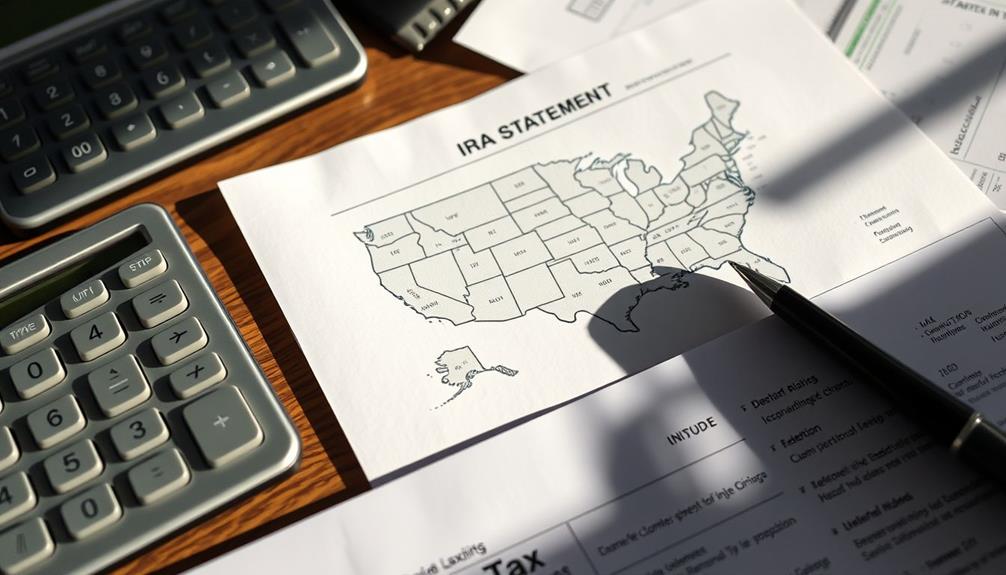When you take out money from your IRA in Connecticut, you will encounter state income tax rates ranging from 2% to 6.99%. Beginning in 2024, there is a 50% exemption on these withdrawals, which will increase to 100% by 2026 for eligible taxpayers. Remember that traditional IRA withdrawals are subject to taxation, while qualified Roth IRA distributions remain tax-free. If you are considering non-qualified withdrawals, be aware of a minimum withholding rate of 6.99%. Understanding these details can help you effectively manage your tax obligations. Stay tuned for more tips on how to optimize your retirement income and reduce taxes.
Key Takeaways
- IRA withdrawals in Connecticut are subject to state income tax rates ranging from 2% to 6.99%, based on income level and filing status.
- Starting in 2024, 50% of IRA distributions will be exempt from state income tax, increasing to 100% by 2026 for eligible taxpayers.
- Non-qualified Roth IRA distributions may incur state income tax on the earnings portion, while qualified distributions remain tax-free.
- Social Security benefits are fully exempt for single filers with AGI below $75,000 and joint filers below $100,000, affecting overall tax liability.
- Monitoring income thresholds and strategically timing withdrawals can help minimize tax liabilities in retirement planning.
Connecticut Tax Overview

In Connecticut, IRA withdrawals are typically subject to a graduated state income tax that ranges from 2% to 6.99%, depending on your income level and filing status. This means that your retirement income from IRA distributions will be taxed according to where you fall on the income scale.
While Connecticut isn't known as one of the most tax-friendly states, there's good news on the horizon. Starting in 2024, eligible taxpayers will see a gradual shift toward more favorable taxation, with a 50% exemption on IRA distributions in 2024 increasing to 100% by 2026.
It's important to note that Connecticut's income tax doesn't provide specific exemptions for Roth IRA withdrawals. Qualified distributions remain tax-free, while non-qualified distributions might incur state income taxes.
If you need to manage your tax liability, be aware that the minimum withholding rate for the taxable portion of non-qualified IRA withdrawals is set at 6.99%. You can customize your withholding options by completing Form CT-W4P, allowing you to adjust based on your personal tax situation and guarantee you're prepared for any state income taxes due on your withdrawals.
Taxation of IRA Withdrawals

Understanding the taxation of IRA withdrawals is key to effectively managing your retirement income. In Connecticut, all withdrawals from traditional IRAs are subject to state income tax, which can range from 2% to 6.99% depending on your income level and filing status.
For eligible taxpayers, the tax exemption for IRA distributions will gradually rise from 50% to 100% by 2026, aligning with existing pension exemptions.
When it comes to non-qualified distributions from Roth IRAs, be aware that state income tax may apply to the earnings portion, while qualified distributions are tax-free.
If you withdraw funds from your traditional IRA, the minimum withholding rate for the taxable portion of non-qualified withdrawals is set at 6.99%. Significantly, no withholding is necessary for qualified distributions.
You can customize your withholding amounts by completing Form CT-W4P, enabling you to choose higher or lower withholding based on your individual tax situation.
Understanding these nuances will help you plan your withdrawals more effectively and minimize your tax burden during retirement.
Exemptions for Retirement Income

Retirement income in Connecticut benefits from several exemptions that can greatly reduce your tax burden. For instance, withdrawals from Individual Retirement Accounts (IRAs) are subject to state income tax, but you can enjoy a phased exemption. Starting in 2024, you'll see 50% of your IRA distributions exempt from tax, increasing to 75% in 2025, and reaching full exemption by 2026 for eligible taxpayers. This gradual change can appreciably lighten your financial load.
Additionally, certain retirement income sources are fully exempt from Connecticut state income tax, which includes military pensions and railroad retirement benefits. This offers you more financial relief as you plan your retirement.
Furthermore, if you're receiving Social Security benefits, you're in luck—these benefits are fully exempt for single filers with an Adjusted Gross Income (AGI) below $75,000 and joint filers below $100,000.
Connecticut State's approach to these exemptions reflects a commitment to easing the financial burdens on retirees, making it essential for you to understand and take advantage of these benefits to maximize your retirement income.
Social Security Tax Implications

When planning your retirement income, it's crucial to understand how Social Security benefits are taxed in Connecticut.
If your Adjusted Gross Income exceeds specific thresholds, you may face a partial tax on your benefits.
Knowing these exemptions and income limits can help you manage your finances more effectively.
Tax Exemptions Overview
Often overlooked, tax exemptions for Social Security benefits in Connecticut can considerably impact your financial planning. If your Adjusted Gross Income (AGI) falls below $75,000 as a single filer or $100,000 as a married couple filing jointly, your Social Security income is fully exempt from state income tax. This means you can enjoy your retirement income without additional tax burdens.
However, if your AGI surpasses these thresholds, a partial exemption kicks in, allowing you to exclude up to 25% of your Social Security benefits from taxation. This structure is designed to support lower-income retirees, ensuring that their tax burdens remain manageable.
Understanding these tax exemptions is essential for Connecticut retirees looking to optimize their financial situations. By factoring in these benefits, you can better plan for your retirement and make more informed decisions regarding your IRA withdrawals and other income sources.
Being aware of how these exemptions align with federal rules can also provide you with valuable tax relief. Overall, knowing how Social Security income is treated in Connecticut will help you navigate your retirement finances with greater confidence.
Income Thresholds Impact
Many retirees mightn't realize how income thresholds can markedly affect the taxability of their Social Security benefits. In Connecticut, knowing these thresholds is essential for your financial planning, especially if you're relying on retirement savings.
Here are some key points to ponder:
- Single filers with a federal adjusted gross income (AGI) below $75,000 can fully exempt their Social Security benefits from state income tax.
- Couples filing jointly with an AGI below $100,000 also enjoy full exemption.
- Exceeding these thresholds may subject up to 25% of your Social Security income to tax, increasing your overall tax liability.
- Understanding these income tax rates can help you manage the tax on retirement, including IRA withdrawals.
- Monitoring changes in these thresholds guarantees you optimize your tax situation and maintain a favorable effective property tax rate.
Property Tax Considerations

Maneuvering the complexities of property taxes in Connecticut can feel overwhelming, especially for retirees on fixed incomes. With an average effective property tax rate of 1.78%, considerably higher than the national average, you need to budget carefully to manage your overall tax burden. The median property tax payment is around $6,096 annually, which can strain your finances when relying on pension income or retirement benefits.
Fortunately, Connecticut offers property tax credits to help alleviate some of this financial stress. Married couples may qualify for up to $1,250 in credits, while individuals can receive as much as $1,000 based on age and disability status.
Additionally, the state's property tax circuit breaker program provides further financial relief for eligible seniors, allowing you to offset high property tax expenses.
As you navigate these property tax considerations, remember that Connecticut's income tax and statewide sales tax can also impact your financial planning. Careful management of your assets and expenses will be essential in ensuring you remain comfortable throughout your retirement.
Make sure to explore all available options to ease the burden of property taxes in your golden years.
Financial Planning Strategies

When planning your IRA withdrawals, consider the withholding rate, as it can affect your tax bill and overall retirement income.
Timing your withdrawals is also essential; withdrawing at the right moments can help minimize your tax liability.
Withholding Rate Considerations
Understanding withholding rate considerations is essential for managing your IRA withdrawals effectively. In Connecticut, you need to be aware of how these rates can impact your state income tax and overall tax liability.
Here are key points to keep in mind:
- The minimum withholding rate for taxable IRA withdrawals is 6.99%.
- Qualified distributions from IRAs are exempt from state income tax, so no withholding applies.
- You can request additional withholding on your distributions if you anticipate a higher tax liability.
- To customize your withholding amounts, complete Form CT-W4P.
- Being aware of your personal tax situation can help you avoid unexpected tax bills.
Timing of Withdrawals
Effective financial planning involves not just knowing your withholding rates but also strategically timing your IRA withdrawals. In Connecticut, the timing of your withdrawals can greatly impact your state income tax liability. Traditional IRA withdrawals are taxed at rates ranging from 3.00% to 6.99%, depending on your overall income level.
Additionally, understanding your financial terms can help you make more informed decisions about your retirement assets.
Starting in 2024, eligible taxpayers will benefit from a gradual tax exemption on IRA withdrawals, allowing for a 50% exemption in 2024, 75% in 2025, and 100% by 2026. To minimize your tax liabilities, consider timing your withdrawals to keep your Adjusted Gross Income (AGI) below $75,000 for singles or $100,000 for joint filers.
Additionally, by withdrawing from traditional IRAs first, you can preserve your Roth IRA for later, as those distributions are tax-free in Connecticut.
Frequently Asked Questions
Does Connecticut Tax IRA Withdrawals?
Yes, Connecticut does tax IRA withdrawals. Traditional IRA distributions are subject to state income tax, while non-qualified Roth IRA withdrawals may also incur taxes on earnings. You can manage withholding using Form CT-W4P.
Do You Pay State Income Tax on IRA Withdrawals?
When you dip into your IRA, consider the tax implications. Yes, you'll pay state income tax on those withdrawals in Connecticut, but future changes could lessen that burden. Stay informed for your financial peace.
What States Require Tax Withholding on IRA Distributions?
Some states require tax withholding on IRA distributions, while others don't. It's essential to check your specific state's regulations, as requirements can vary greatly, impacting your overall tax liability when you withdraw funds.
What Is the State of CT Tax Withholding on Pension Payments?
In Connecticut, you'll face a minimum withholding rate of 6.99% on taxable pension payments. You can customize your withholding by completing Form CT-W4P, helping you better manage your overall tax obligations.
Conclusion
In steering through the complexities of IRA withdrawals in Connecticut, understanding state tax implications can save you a significant amount of money. Remember, "a penny saved is a penny earned." By familiarizing yourself with retirement income exemptions and planning your finances wisely, you can make the most of your hard-earned savings. Stay informed about Social Security and property tax impacts to enhance your overall financial strategy, ensuring a smoother shift into retirement.










